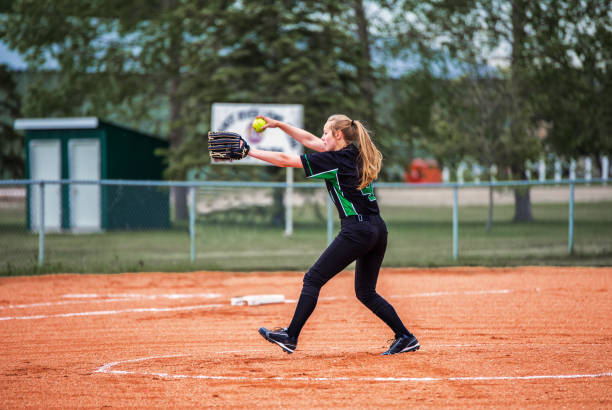Introduction
Learning to pitch in softball starts with mastering the fundamentals of underhand delivery. Unlike baseball’s overhand motion, softball pitching requires a completely different set of mechanics that emphasize consistency, accuracy, and proper form over raw speed. For beginners, developing correct habits from the start prevents bad mechanics that become difficult to fix later. The underhand motion relies on a smooth, pendulum-like arm swing combined with proper leg drive and body positioning. These basic drills focus on building muscle memory for the essential components: stance, grip, arm motion, and follow-through. With consistent practice of these foundational exercises, new pitchers can develop the confidence and control needed to succeed on the mound.
Basic Stance and Grip Fundamentals
Your pitching foundation begins with proper stance and grip mechanics. Many beginners struggle with consistency because they never establish reliable starting positions for their delivery. A solid stance provides balance and power transfer, while correct grip techniques ensure consistent ball release and movement.
The proper pitching stance requires feet positioned shoulder-width apart with your pitching foot in contact with the rubber. Your weight should be evenly distributed between both feet, with a slight bend in your knees to maintain an athletic position. Keep your shoulders square to home plate and position your glove hand at chest level for optimal balance.
Grip development focuses on control rather than trying different pitch types early on. Use a four-seam grip with your fingers positioned across the seams for straight pitches, keeping your thumb underneath the ball for support. Maintain firm but relaxed grip pressure, as tension creates inconsistency.
Essential drills for this foundation include:
- Mirror work for stance practice
- Wall alignment checks for shoulder positioning
- Balance holds to build stability
- Partner stance verification
Arm Motion and Release Mechanics
The underhand arm swing distinguishes softball pitching from all other throwing motions in sports. This pendulum-like movement generates power through momentum rather than muscle force, making proper mechanics crucial for both effectiveness and injury prevention. Beginners often rush this motion or try to force speed before mastering the fundamental swing path.
Your arm motion should begin with the ball positioned in your glove at chest level, followed by a smooth backward motion while keeping your arm straight. The forward swing follows gravity naturally, with your release point occurring at hip level. Complete follow-through brings your arm across your body, finishing the natural pendulum arc.
Release point consistency determines your accuracy more than any other single factor. Focus on releasing the ball at the same spot relative to your body for every pitch, using ground targets to practice precision. Keep your wrist firm through the release, then snap it downward after the ball leaves your hand.
Practice drills include:
- Shadow pitching for muscle memory development
- Fence drills for proper arm path
- Towel exercises focusing on arm speed
- Progressive distance work starting at 15 feet
Leg Drive and Power Transfer
Power in softball pitching comes primarily from your lower body, not your arm. Many beginners focus too heavily on arm strength while neglecting the leg drive and weight transfer that generate real velocity and control. Understanding how to coordinate your legs with your arm motion creates a smooth, powerful delivery.
Effective leg drive begins with pushing off the pitching rubber with your back foot while stepping forward with your stride foot toward your target. Your hips should rotate during this movement to generate additional power, and you should land on the ball of your stride foot while maintaining balance throughout the entire motion.
Weight transfer works in coordination with your arm swing. Start with your weight primarily on your back foot, then shift your weight forward as your arm swings toward release. Complete the weight transfer at your release point, allowing your back foot to come forward naturally during follow-through.
Key development drills include:
- Step-through exercises focusing purely on leg movement
- Resistance band training for power development
- One-knee drills to isolate upper body mechanics
- Stride length consistency work using ground markers
Developing Accuracy and Control
Accuracy separates successful pitchers from those who struggle with walks and wild pitches. Control comes from consistent repetition of proper mechanics combined with focused target practice. Beginning pitchers should prioritize throwing strikes before worrying about pitch location or movement.
Target practice should begin with large, forgiving targets that build confidence before progressing to smaller, more precise zones. Use a strike zone frame for visual reference and practice hitting different areas systematically rather than randomly. Start your practice sessions at shorter distances, around 20 feet from your target, then gradually increase distance as your accuracy improves.
Distance progression training helps build arm strength while maintaining mechanical consistency. Only move to full mound distance after achieving consistent success at closer ranges. Remember that proper mechanics should remain the same regardless of the distance you’re throwing.
Effective accuracy drills include:
- Bucket targeting for confidence building
- Corner practice for strike zone command
- Count situation games adding pressure
- Systematic location sequences
- Called target exercises
Common accuracy problems include rushing your delivery (causing high pitches), inconsistent release points (creating left-right misses), and poor follow-through (leading to short pitches).
Conclusion
Building solid pitching fundamentals requires patience and consistent practice of these basic drills. Focus on one element at a time rather than trying to perfect everything simultaneously. Start with stance and grip, then add arm motion, incorporate leg drive, and finally work on accuracy. Remember that developing muscle memory takes time, so practice these drills regularly in short sessions rather than long, infrequent workouts. Quality repetitions matter more than quantity. As these basics become automatic, you’ll have the foundation needed to add advanced techniques and develop into a confident, effective pitcher.Ready to accelerate your pitching development? Athletes Untapped connects aspiring pitchers with experienced private coaches who specialize in softball fundamentals and advanced techniques. Find qualified instructors in your area.




